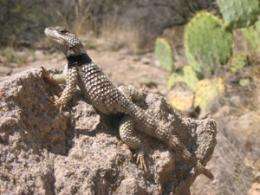Global warming: Changing interactions between species may be more dangerous than high temperatures alone

(Phys.org)—Climate change causes extinctions not only as a result of species intolerance to high temperature, but more commonly via a variety of related factors that alter a species' interactions with other species, according to a new review published in Proceedings of the Royal Society B. Contrary to expectations given global warming, researchers from Stony Brook University found little evidence that many species have gone locally extinct or declined due to direct effects of higher temperatures. Instead, climate change was found to typically lead to local extinctions and declines by influencing interactions between species, such as reducing prey populations for predators.
Researchers reviewed 136 studies that suggested that climate change was associated with local extinctions or declines and found just seven for which the primary cause ("proximate cause") of extinction could be identified. Of these, none of the seven showed a straightforward relationship between a local extinction and limited tolerances to high temperature, and most implicated species interactions, such as declines in prey species or increased disease spread, as the proximate cause. Additionally, seven studies of population declines related to recent climate change showed a very similar pattern, as did four studies of declines related to natural climatic oscillations.
Author, Professor John J. Wiens, said: "Dozens of studies have shown local extinctions and declines that appear to be associated with recent, human-related climate change. For most of these cases, the primary cause of the declines has not been identified, highlighting our worryingly limited knowledge of this crucial issue. However, where causes have been identified, changing species interactions have been found to be key in the majority of cases. Because many of these impacts have already happened and climate has changed only a little so far relative to the predicted changes in the next 100 years, our results suggest that these shifting interactions may make even small climatic changes dangerous for the survival of populations and species."
The researchers identified a number of factors ("proximate causes") hypothesised to lead to extinction from climate change, principally:
- Impacts of limited physiological tolerance to changes in temperature, with specific proximate causes including decreased activity time and increased energy maintenance costs leading to starvation, or reduced oxygenation of water
- Impacts of limited physiological tolerance to changes in precipitation, with species proximate causes including loss of habitat for freshwater species or life stages and water stress and death in terrestrial species
- Climate-related impacts on beneficial species, for example extinction or declines of prey species, pollinators or host species
- Climate-related impacts on harmful species, for example increases in predators, competitors and pathogens
- Changes to activity times of interacting species due to changes in different cues such as temperature and photoperiods
They then identified seven studies of population declines associated with climate change (given that these declines can lead to extinction). They found similar patterns, with species interactions being the most frequent proximate cause of declines, including climate-related reductions in food for three bird species (a plover, a jay, and an auklet), and declines due to climate-related spread of a fungus in dozens of species in a genus of tropical frogs (Atelopus). Declines were also related to limited precipitation (in an African aloe tree and four North American amphibians) and oxygen limitation at higher temperatures in a fish (eelpout).
Finally, they found that local extinctions and declines due to climatic oscillations (rather than long-term trends) were also due primarily to species interactions, including climate-related loss of figs for fig wasps, loss of symbiotic algae for corals, loss of coral used for food by a butterfly fish, and disease spread in a toad.
Professor Wiens added: "Currently our knowledge of the ways in which climate change can lead to species extinctions is extremely limited. Understanding the proximate causes of extinction from climate change should be an urgent priority for future research if we are to develop effective conservation strategies to ameliorate their effects."
More information: rspb.royalsocietypublishing.or … .1098/rspb.2012.1890
Journal information: Proceedings of the Royal Society B
Provided by The Royal Society



















